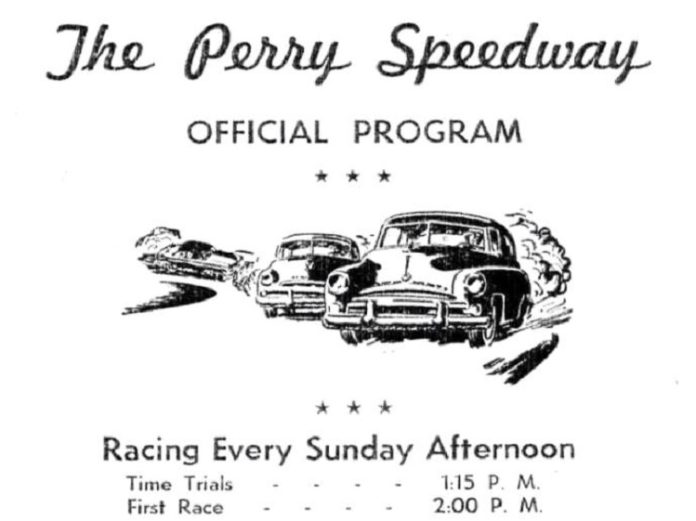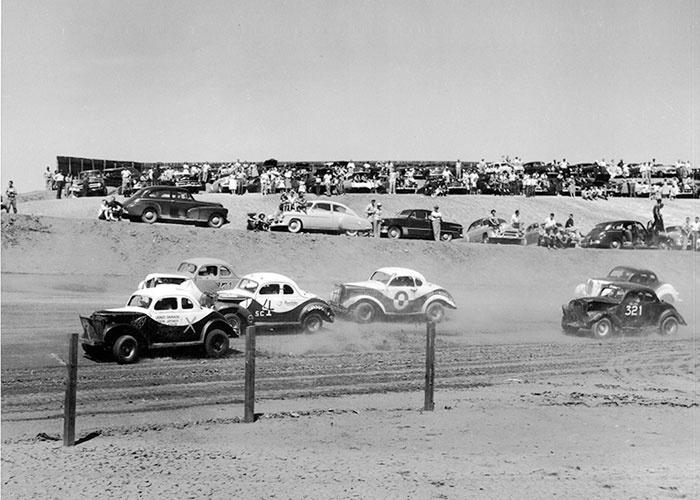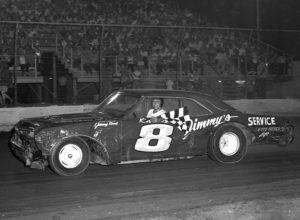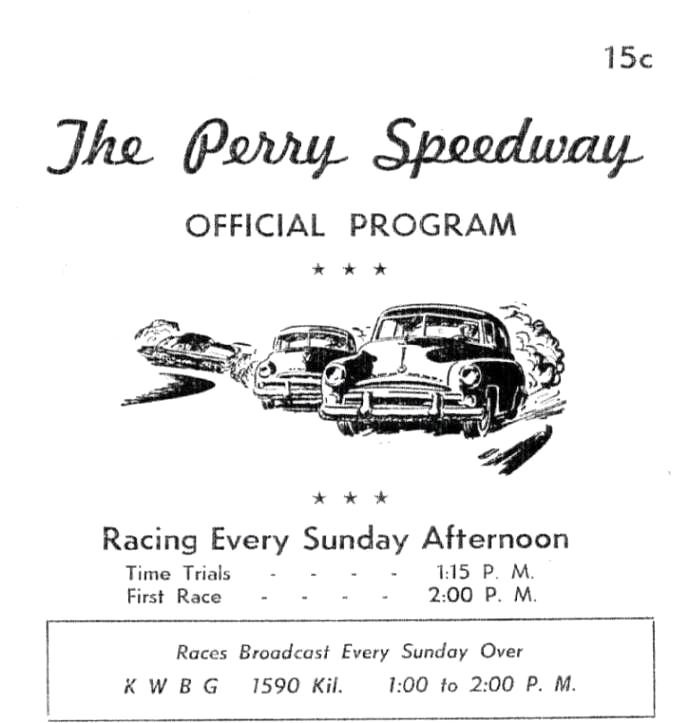

Among the many entertainments people in Perry have indulged in over the years was the now largely forgotten Perry Speedway owned by Les Martinie of Perry. Post-war America ruled the world, and our gas-guzzlers were second to none when the Perry Speedway was at its zenith.
Many people might not be aware the first auto racing track in Perry was located at the Tri-County Fairgrounds at the south end of Perry, near the present location of the Perry Hy-Vee. The Tri-County track was originally built for horse racing but with the popularity of the automobiles in the 1920s and ’30s, an interest was sparked in auto racing.
By the late 1950s and early ’60s, Perry also had a motorcycle club that raced at the Tri-County Fairgrounds, but the popular favorite was the Perry Speedway, located in the 2600 block of First Avenue on Perry’s north side. The track was on the west side of First Avenue, south of the present day Bar-Jac Mobile Estates.
Along with owning the Perry Speedway, Martinie was in the business of selling farm machinery. He was also a commercial truck driver and a custom farmer. He was well known for the many years for following the wheat harvesting, beginning in Oklahoma and continuing through North Dakota.
Some readers might remember the big, white house standing on the Martinie property, where it was surrounded by Massey Ferguson combines and other farm equipment.
According to historical records, building the Perry Speedway required moving 15,000 cubic yards of dirt. It took about six weeks and 3,200 labor hours to complete. The large track was just 300 feet shy of one-half mile on the inside of the track, making it the second-longest track in Iowa at that time.
The track on the infield was about one-quarter mile long. There was a small concession stand between the race track and the house, where patrons could buy popcorn, pop and other refreshments. The concession stand was run by Martinie’s daughters, Barbara and Maxine, when they were about 10 years old.
Racing at the Perry Speedway started in 1954, and most of the cars running were Ford flathead V-8s. Some of the prewar vintage autos included modified coups, mostly Fords but also a few Plymouth and Dodge flathead six-cylinder cars.
 The glass was removed from the cars, and an 1.5-inch pipe was welded onto the body to make a roll bar. The driver’s door was welded shut. Early seat belts were made out of canvas, but later seat belts were used from small airplane cockpits.
The glass was removed from the cars, and an 1.5-inch pipe was welded onto the body to make a roll bar. The driver’s door was welded shut. Early seat belts were made out of canvas, but later seat belts were used from small airplane cockpits.
The cars were plain, and numbers were painted on the doors and on the back of the cars.
To enjoy one of the stock car races at Martini’s Perry Speedway, you would need to have a Sunday afternoon free, beginning at 1:15 p.m. when the time trials were held. Races followed the time trials at 2 p.m.
After a while, lights were installed at the speedway for night races. If you weren’t able to attend the race in person, they were broadcast on KWBG radio station in Boone and Perry.
Longtime Perry sports writer Harold Bailey covered the races for the local newspaper so that race fans could keep track of their favorite driver even if they weren’t in the stands.
Race day began with the time trials somewhat like they are today. Times around the track were in the 30-second range. There was a trophy dash that was six laps, with the heat lap races at eight laps. Trophies were presented for both races.
Halfway through the event came a special race called the Australian pursuit. Times for this race were taken from the initial time trials. Cars with the fastest time were in the rear of the lineup, with slower cars in front. If there were 10 cars running, there would be 10 laps in the Australian pursuit. The final car from each lap was eliminated.
Rather than the highly trained and well-equipped pit crews seen today, the pit crew at the Perry Speedway consisted of a couple of the driver’s friends or maybe neighbors — no technical training given.
Instead of the expensive diagnostic equipment used in today’s pits, the “junk boxes,” as they were called, contained assorted wrenches, a four-bar lug wrench and a jack. There were only two spare tires rather than the large number of tires used on today’s cars.
Racing involved many secrets for increasing the speed of the stock cars at the Perry Speedway, including placing moth balls in the gas tank, adding aviation fuel to the gas and adding water to the back tires to give better traction. These secrets were shared by some of the guys who actually ran cars in Perry.
Another secret shared by a local driver included the popularity of stock car racing in the early years when drivers who raced in Perry also raced at tracks in Adel and at the Pioneer Race Track in Des Moines.
One of drivers said that at the Adel Track, a $5 prize was given to the first driver who rolled his car. The driver said if things weren’t going well during the regular race, he would roll his car just to get the $5 to have his vehicle hauled back to Perry.
While many may believe women had no interest in car racing during the early years, that belief is incorrect. Lee Pinkney of Des Moines, driving a lavender car with hot pink numbers on the side, was the favorite of the local female racing population.
Although Pinkney was a crowd pleaser for the female spectators, other popular drivers at Martinie’s Perry Speedway included Jesse Fagen, sponsored by Cliff Fagen’s Conoco Station,
Shorty Masengill’s Clover Leaf 4, sponsored by Dean Campbell of Perry Municipal Airport, and Harry Ridgeway of east Perry Conoco Station. Ned Freestone of Redfield raced for Palmer Motors of Perry.
Other drivers included Leo Welder, Marion McNeil, Norman Parker, Tom Haley, Floyd Fagen
of Perry, Hans Nicholasen and Clyde Alexander, both of Angus, Dean Beaver of Adel, Joe Rensch of Cooper, Kenny Dever of Des Moines and Paul Wellander of Pomeroy.
In addition to the drivers, it took many people to make Perry Speedway a success. Officials at the Perry track included board of directors Bernard Miner of Perry, Jim Hutchinson of Dallas Center and Dean Beaver of Adel and alternates Ned Freestone of Adel and Floyd Fagen of Perry.
The board of judges included Kenneth Heisler, Mrs. Bernard Miner, Herbert Thomas and Eldon Hastie of Perry, Darrell Daugherty of Adel and Gene Tolle of Dawson. The chief flagmen was Ed Rachels of Perry. The track steward was Larry Potter of Perry. The announcer was Danny Shaw of Des Moines. Ed Rachels and Eldon Hastie of Perry handled the promotion and advertising.
Unlike today’s million-dollar contracts and sponsorships, sponsorships in the 1950s at Martinie’s were very much appreciated and an integral part of the success not only of the
drivers and raceway but of the broader Perry community. Some of these sponsors included Sedars Pontiac at 808 Second St., Raccoon Implement Co. on east Willis Avenue, Palmer Motors at 1216 Otley Ave., Risteveldt’s Coast to Coast on Second Street, Vince Motors Ford and Mercury on Railroad Street, the Perry Bottling Co. at 919 Railroad St., Ed, Cliff and Homer at NAPA Parts Supply at 1015 Railroad St., Hawn’s Skelly Service on east Willis Avenue, G.H. & W Implement Co. at 2701 Willis Ave., Brooks Ice Cream at 1215 Bateman St., Spic and Span Cleaners at 1116 Rawson St. and McTigue Hardware at Second Street and Willis Avenue.
Another racing experience in Perry during the late 1950s and ’60s was a go-kart track located on property owned by Triggs Manufacturing, where Peters Service now trades on W. Willis Avenue. Triggs also made frames for go-karts.
Many people contributed time and memories to the writing of this article for the Perry Historic Preservation Commission. The commission dearly thanks Harry Ridgeway of Perry, the late Shorty Masengill of Dawson, Maxine Martinie of Washington state and Ned Freestone of Arizona.


















Better start doing fact checks. NASCAR was started February 21, 1948.
The point to be made is the Perry Speedway was entertaining folks here before NASCAR became a cultural phenomenon in this part of the country even though NASCAR predated the Perry Speedway itself. NASCAR wasn’t here. The Speedway was.
Great place and a time of life enjoyed. Thanks for the free drinks, Barb, LOL! –JJK
I remember going to the races with my father, Harold Phipps. We loved watching and cheering for Jesse Fagen. We have Fagen relatives. I would love to see an article about Happy Hollow Wildflower Park that was built by Victor and Ruth Fagen. It was a magical place enjoyed by so many.
Dreams come true on The Perry News. Just click here: https://theperrynews.com/remember-when-children-could-play-in-the-fresh-air-and-sunshine/
I was told that the Perry Speedway had put on a “Nationals” event in the 1950s so I did some research at the State of Iowa Historical Bldg. Without going back to my notes (it was nearly 10 years ago that I did this research) I recall a multi-day show involving the old “stock cars”, motorcycles, (maybe midgets), and one other form of race car. I was interested in the stock car portion of the event. What I discovered was that the winner refused to be “torn down” for out of stock parts and left with the trophy but not the money.